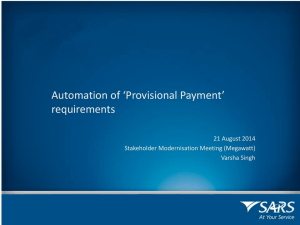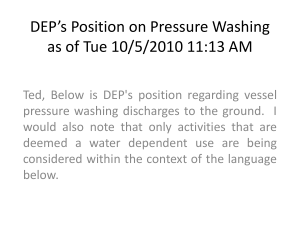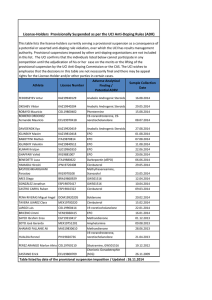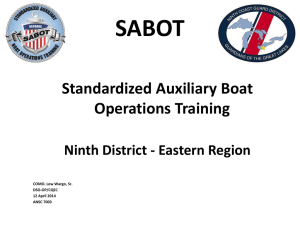Leon_TRYTON - Clinical Trial Results
advertisement
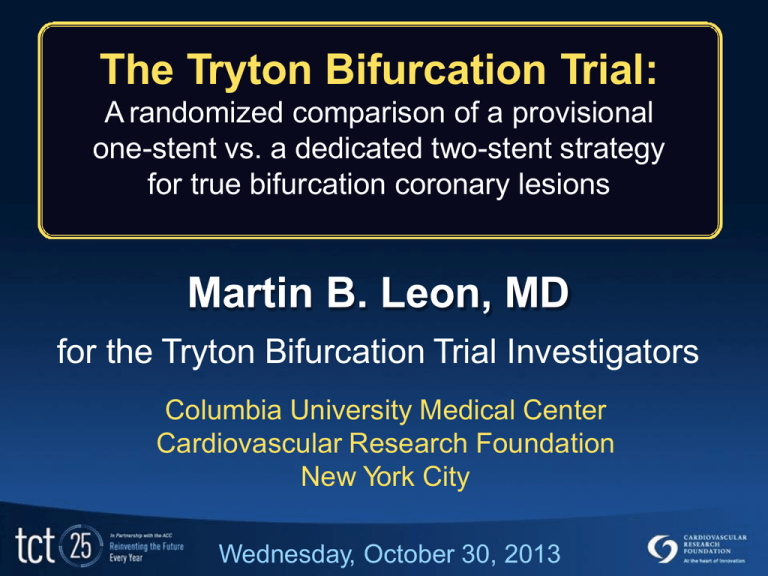
The Tryton Bifurcation Trial: A randomized comparison of a provisional one-stent vs. a dedicated two-stent strategy for true bifurcation coronary lesions Martin B. Leon, MD for the Tryton Bifurcation Trial Investigators Columbia University Medical Center Cardiovascular Research Foundation New York City Wednesday, October 30, 2013 Disclosure Statement of Financial Interest TCT 25: San Francisco, CA; Oct 27 - Nov 1, 2013 Martin B. Leon, MD Within the past 12 months, I or my spouse/partner have had a financial interest/arrangement or affiliation with the organization(s) listed below. Affiliation/Financial Relationship Company • Research Support (CUMC) • Abbott, Boston Scientific, Medtronic • Consulting Fees/Honoraria • None • Major Stock Shareholder/Equity • None Purpose of the Study • To compare the clinical outcomes and angiographic results of the accepted provisional one-stent strategy vs. the Tryton bifurcation two-stent approach in a randomized controlled trial of true coronary bifurcation lesions. Tryton Side Branch Stent 8 mm 4.5 mm 6.5 mm Main Branch Zone Transition Zone Side Branch Zone Tryton is a Cobalt alloy bare metal stent Stent l ength 19mm (18mm*) rger -Stent diameter sites 3.0 • 3.Snvn and 3.S • 4.0mm. Main Branch Diameter (mm) Side Branch Diameter(mm) 2.5 2.5 3.0 2.5 3 .5 2.5 3.5 4.0 Recently Added 3.0 3.5 Tryton Deployment Sequence Tryton positioned and deployed after pre-dilatation (secures and protects side branch) Main vessel treated with approved DES through main vessel portion of Tryton Kissing balloon post-dilatation to insure complete lesion & ostium coverage Tryton Study Design Baseline Angiography – Eligible for Randomization Tryton side branch + DES (main vessel) N = 704 Clinical F/U at 9 months Angiographic F/U at 9 months TVF Primary Endpoint DES (main vessel) + Provisional side branch Clinical F/U at 9 months % DS side branch n~374 IVUS F/U at 9 months Angiographic F/U at 9 months IVUS Cohort n~96 IVUS F/U at 9 months Inclusion Criteria • Single de novo “true” bifurcation lesion in a native coronary artery involving both the main vessel and the side branch (Medina classification 1.1.1, 1.0.1, or 0.1.1 by visual assessment) • Symptoms or objective evidence of ischemia • Vessel diameter: main vessel ≥ 2.5 mm and ≤ 4.0 mm; side branch ≥ 2.5 mm and ≤ 3.5 mm • Lesion length: main vessel ≤ 28 mm; side branch ≤ 5 mm • Limited treatment of multi-vessel disease and staging, per protocol (after successful treatment of ≤ 2 noncomplex, non-target lesions) Key Exclusion Criteria Clinical… • STEMI < 72 hours or STEMI/non-STEMI > 72 hours and • • • • increased CK-MB Hemodynamic instability Creatinine > 2.5 mg/dL or dialysis Bleeding diathesis or hypersensitivity to anticoagulant meds LVEF < 30% Anatomic… • Left main disease (unprotected or protected) • Trifurcation lesion • Complex morphology: severe Ca++, thrombus, TIMI 0/1 flow, severe tortuosity Primary and Secondary Endpoints • Study design: Intention-to-treat (ITT) is primary analysis cohort, 1:1 randomization • Primary Endpoint: Target vessel failure @ 9 months follow-up (all patients): non-inferiority cardiac death target vessel MI (peri-procedural > 3X CK-MB) target vessel revascularization (ischemia-driven, main vessel or side branch) • Secondary Endpoint: % diameter stenosis (in-segment) of side branch at 9 months follow-up (angiographic cohort only): superiority Operator Technique Recommendations Tryton • Pre-dilation (optimal lesion preparation) • Tryton placement followed by POT (at ostium) • DES placement followed by final kissing balloon dilation (with NC balloons) Provisional • Standard operator technique for pre-dilation and DES placement • Side branch intervention (balloons or stents) only if… < TIMI 3 flow, ≥ type B dissection, or > 80% stenosis • Final kissing balloon dilation (with NC balloons) Trial Administration Principal Investigator Martin B. Leon MD Columbia University Medical Center Study Chairman Patrick W. Serruys MD, PhD Erasmus MC, Rotterdam Imperial College, London Executive Committee Antonio Bartorelli MD, Thierry Lefèvre MD Pieter Stella MD PhD, William Fearon MD James Hermiller MD, Dean Kereiakes MD David Williams MD Data Management and Biostatistics Donald E. Cutlip MD Harvard Clinical Research Institute Data Safety Monitoring Board Chairman: Robert S. Safian MD Beaumont Health System Clinical Events Committee Donald E. Cutlip MD Harvard Clinical Research Institute Angiographic Core Lab Philippe Généreux MD Cardiovascular Research Foundation IVUS & 3D Angiographic Core Lab Hector Garcia-Garcia MD, PhD Cardialysis, Rotterdam, The Netherlands Sponsor Aaron V. Kaplan MD, Linn Laak Tryton Medical, Inc. Enrollment Cadence 23 months to complete enrollment 207 Enrollment: 28 U.S. sites (32%) 30 non-U.S. sites (68%) 2011 2012 OCT Enrollment by Site Paula Stradins Clinical University Riga, Latvia I. Kumsars Mount Sinai Medical Center New York, NY S. Sharma OLVG Amsterdam, The Netherlands T. Slagboom Karol Marcinkowski University Hospital Ponzan,Poland M. Lesiak AMC Department of Cardiology Amsterdam, The Netherlands J. Wykrzykowska Szegedi Tudományegyetem Szeged, Hungary I. Ungi Gottsegaen Gyorgy Orszagos Kardiologai Budapest, Hungary G. Fontos 54 Wellmont CVA Heart Institute 44 UMCU Heidelberglaan 41 Ziekenhuis Oost-Limburg 37 MediQuest Research Group 26 CHU Leige Domaine Univer du Sart Tilman 25 Hopital Rangueil 25 ZNA Kingsport, TN C. Metzger Utrecht, The Netherlands P. Stella Genk, Belgium J. Dens Ocala, FL R. Feldman Liege, Belgium V. Legrand Toulouse,France D. Carrié Antwerpen, Belgium G. Van Langenhove 24 22 20 18 18 17 16 Enrollment by Site Erasmus MC Thoraxcenter 16 Rotterdam,The Netherlands R. van Geuns Castle Hill Hospital Brussel, Belgium P. Kayaert AZ Sint-Jan Cardiology 15 14 Nieuwegein, The Netherlands M. J. Suttorp Rabin MC Belinson Campus Petach Tivka Israel A. Assali 12 Golden Jubilee Hospital 12 Glasgo, United Kingdom A. Oldroyd 14 Tallahassee Research Institute, Inc. 11 Tallahassee, FL W. Batchelor 13 St. Vincent Medical Group, Inc. 11 Indianapolis, IN J. Hermiller Palo Alto, CA W. Fearon St. Antonius Ziekenhuis Monzino Hosptail Centro Cardiologico Milan, Italy A. Bartorelli Brugge,Belgium L. Muyldermans Stanford University Medical Center and VA 12 Breda, The Netherlands P. den Heijer Cottingham,United Kingdom A. Hoye UZ Brussel Amphia Ziekenhuis 13 Scottsdale Healthcare 12 Padova University Hospital 11 Scottsdale, AZ D. Rizik Padova, Italy G. Tarantini 11 Patient Flow Randomized N=704 Tryton + DES N=355 Tryton 4= Lost to F/U 2= Patient withdrawal 4= Death Provisional + DES N=349 9 Month Follow-up N=681 Tryton = 345 Provisional = 336 Angiographic N=326 Tryton= 158 Provisional= 168 Provisional 6= Lost to F/U 5= Patient withdrawal 4= Death IVUS N=9 4 Tryton= 59 Provisional= 35 • Clinical FU at 9 months = 97% • Angiographic FU at 9 months = 87% Patient Demographics Characteristic (%) Provisional (N=349 Patients) Tryton (N=355 Patients) 64.6±9.4 64.5±10.6 Male 73.4 71.8 MI PCI CABG TIA / CVA CHF Diabetes Mellitus Hypertension Hypercholesterolemia Current Smoking Atrial Fibrillation 37.8 41.8 2.0 5.2 0.9 28.1 73.6 77.3 15.2 6.9 30.0 38.0 2.5 6.1 1.7 23.9 73.2 74.1 17.5 10.7 Age (years) Patient Demographics Characteristic (%) Recent MI Provisional (N=349 Patients) Tryton (N=355 Patients) 9.7 10.7 74.8 19.8 73.8 20.0 16.7 13.6 55.1 22.9 5.3 63.2 57.5±9.8 57.6 25.2 3.6 62.7 57.7±9.6 Angina Type Stable Unstable CCS Class I II III IV Functional test (+ ischemia) LVEF Main Vessel Characteristics Characteristic (%) Vessel Location LAD LCX RCA Lesion Location Ostial Proximal Mid Distal Reference Vessel Diameter (mm) Lesion Length (mm) Morphology angulation ≥45o thrombus calcification – mod/severe TIMI Flow (baseline) < 3 Provisional (N=349 Patients) Tryton (N=355 Patients) 75.1 18.6 6.3 76.6 17.8 5.6 4.3 49.0 19.8 26.9 2.91±0.35 15.96±6.83 7.3 44.4 24.3 24.0 2.91±0.36 16.81±7.25 8.9 1.1 22.3 8.9 10.2 0.8 16.4 7.9 Side Branch Characteristics Characteristic (%) Vessel Location LAD LCX RCA Lesion Location Ostial Proximal Mid Distal Reference Vessel Diameter (mm) Lesion Length (mm) Morphology angulation ≥45o thrombus calcification – mod/severe TIMI Flow (baseline) < 3 Provisional (N=349 Patients) Tryton (N=355 Patients) 74.8 18.9 6.3 77.1 17.2 5.6 97.7 1.4 0.0 0.9 2.21±0.33 4.43±1.12 97.2 1.7 0.3 0.8 2.25±0.30 4.84±1.56 25.9 0.9 7.2 3.4 17.2 0.3 6.7 4.8 Medina Classification (Site Reported) T: 73.2% P: 68.7% T: 11.5% P: 12.4% T: 0.3% P: 0% T: 0% P: 0% “True” Bifurcation T: 14.6% P: 18.7% T: 0% P: 0% P = Provisional T: 99.3% P: 99.8% T: 0.3% P: 0.3% T = Tryton Medina Classification (Core Lab) T:49.2% P:42.1% T: 1.4% P: 2.6% T:15.8% P:16.0% T: 2.3% P: 4.9% “True” Bifurcation T: 24.9% P: 28.1% T: 89.9% P: 86.2% T: 2.8% P: 4.0% P = Provisional T: 3.4% P:2.3% T = Tryton Procedural Details Provisional (N=349 Patients) Non-target lesions treated (%) Non-balloon lesion preparation (%) Tryton stent implanted (%) Tryton (N=355 Patients) 16.9 1.4 0.6 12.1 1.7 96.1 Side Branch Pre-dilation (%) Maximum balloon diameter (mm) Maximum balloon pressure (atm) 60.8 2.4±0.39 10.4±3.62 95.8 2.6±0.37 10.8±4.10 Main Vessel Pre-dilation (%) Maximum balloon diameter (mm) Maximum balloon pressure (atm) 79.8 3.1±0.42 11.3±3.90 89.2 3.1±0.41 11.2±4.20 86.2 85.1 Final “kissing balloon” dilation (%) Additional Side Branch Stents (Site Reported) Provisional (n= 349) Tryton (n= 355) Additional Side Branch Stents Indications (site-reported) units 9 Provisional Tryton 8 7 8.0 6 5 4 4.0 3 2 2.8 2.3 1 2.6 1.4 0 SB Stent Dissection >B TIMI <3 1.7 0 Stenosis ≥80% Tryton Bifurcation Study Main Study Results Target Vessel Failure (TVF)* Primary Endpoint % Provisional Tryton 30 25 20 P=0.108 17.4 15 10 12.8 5 0 * TVF = Cardiac death, TV–MI and TVR Primary Endpoint Target Vessel Failure at 9 Months Tryton Provisional (N = 355) (N = 349) 17.4% 12.8% Difference 4.6% Upper 1sided 95% CI Noninferiority P value 10.3% = 0.4167 Zone of non-inferiority pre-specified margin = 5.5% Non-inferior 0 1.0 2.0 3.0 4.0 5.0 6.0 7.0 8.0 9.0 Primary Non-Inferiority Endpoint Not Met 10.0 % 11.0 Target Vessel Failure (TVF) Primary Endpoint % 20 18 P= 0.108 P = 0.109 17.4 16 14 12 Provisional Tryton 15.1 12.8 10 10.7 8 P =0.564 6 4 4.7 3.6 2 0 0 TVF 0 Cardiac Death Target Vessel MI Non Hierarchical Clinically Driven TVR Stent Thrombosis (ARC) 9-month Follow-up Event - % (n) All – to 270 days definite probable def + prob Early (0-30 days) definite probable def + prob Late (30-270 days) definite probable def + prob Provisional P-Value (N=349) Tryton (N=355) 0.3 (1) 0.6 (2) 1.00 0 0 na 0.3 (1) 0.6 (2) 1.00 0.3 (1) 0.6 (2) 1.00 0 0 na 0.3 (1) 0.6 (2) 1.00 0 0 na 0 0 na 0 0 na Overall = 0.4% Angiographic Results (QCA) Follow-up (9 months) Provisional Main Vessel RVD (mm) MLD (mm) In-stent In-segment % DS In-stent In-segment Side Branch RVD (mm) MLD (mm) In-stent In-segment % DS In-stent In-segment P-Value (N=168) Tryton (N=158) 2.88±0.32 2.95±0.35 0.050 2.44±0.43 2.13±0.48 2.47±0.54 2.14±0.56 0.581 0.851 14.94±12.75 26.02±14.01 16.47±14.28 27.77±15.87 0.308 0.292 2.24±0.31 2.29±0.29 0.103 na 1.36±0.38 1.67±0.62 1.56±0.56 na <0.001 na 38.63±16.16 26.72±25.44 31.57±22.91 na 0.002 Side Branch %DS (In-segment) Secondary Endpoint % Provisional Tryton 60 50 P=0.002 40 38.6 30 31.6 20 10 0 Secondary Superiority Endpoint Met Side Branch % DS (In-segment) Baseline 100% Provisional Tryton Percent of Patients 80% 60% 40% 20% 0 0 20 40 60 % Diameter Stenosis 80 100 Side Branch % DS (In-segment) Final 100% Provisional Tryton Percent of Patients 80% 60% 40% 20% 0 0 20 40 60 % Diameter Stenosis 80 100 Side Branch % DS (In-segment) 9-Month FU 100% Provisional Tryton Percent of Patients 80% 60% 40% 20% 0 0 20 40 60 % Diameter Stenosis 80 100 Angiographic Results Binary Restenosis (9 months) Provisional P-Value (N=168) Tryton (N=158) In-stent 1.8 4.4 0.208 In-segment 8.9 10.1 0.851 na 20.4 na 26.8 22.6 0.439 na 21.6 na 33.3 28.2 0.337 Main Vessel (%) Side Branch (%) In-stent In-segment MV or SB (Total, %) In-stent In-segment Restenosis Location (QCA) Provisional Proximal 9 (5.4%) Restenosis @ SB ostium: 75% Provisional 62% Tryton Tryton Proximal 10 (6.3%) Tryton Bifurcation Study Post-hoc Subset Analyses Target Vessel - MI 3X, 5X, 10X CK-MB Only Criteria % 20 Provisional Tryton 18 16 14 12 P= 0.162 10 9.6 8 6 P = 0.256 6.6 4 5.2 2 3.3 P = 0.123 0.3 0 3X 5X 1.7 10X % 50 Occulostenotic Paradox Restenosis vs. TLR (Side Branch) Restenosis TLR 45 40 35 30 25 20 15 26.8 24.5 22.6 88.5% 94.4% 2.9 1.5 91.5% 10 5 0 2.2 Combined Tryton Provisional Target Vessel Failure (TVF) Side Branch ≥ 2.25 mm Diff (95% CI) = -4.3% (-12.2, 3.7%) % 18 16 14 Provisional Tryton P= 0.383 15.6 P = 0.563 12 12.1 11.3 10 9.2 8 6 P =0.769 4 4.3 2 0 0 TVF 3.5 0 Cardiac Death Target Vessel MI Non Hierarchical Provisional (N=141) Tryton (N=141) Clinically Driven TVR Angiographic Outcomes (QCA) Side Branch ≥ 2.25 mm % 50 45 40 P = 0.004 40.6 P = 0.260 35 30 Provisional Tryton 30.4 32.1 25 20 22.2 15 10 5 0 SB In-segment % DS Provisional (N=81) Binary Restenosis Tryton (N=63) Conclusions • The Tryton two-stent strategy in true bifurcations (88%) compared with the provisional strategy (8.0% side branch stents) did not meet the non-inferiority clinical endpoint (TVF), due to a relatively higher frequency of small peri-procedural CK-MB elevations. • However, both strategies were safe (rare clinically significant MIs and stent thrombosis) and both had low 9-month clinically-driven TVR (P:3.6%,T:4.7%). • DES in the main vessel performed well in both arms. • Tryton improved side branch % diameter stenosis at FU (secondary endpoint; P=0.002) Conclusions • Post-hoc subset analyses indicated: A striking disparity between binary restenosis and clinically-driven TVR for both arms, indicating that side branch angiographic restenosis is uncommonly expressed clinically. Improved clinical and angiographic outcomes with Tryton in larger side branches (> 2.25 mm side branches = 41% of enrolled patients). Clinical Implications • It’s difficult to enroll complex “high-risk” bifurcation lesions in clinical trials (only 41% had side branches ≥ 2.25 mm). • Small peri-procedural CK-MB elevations occur more frequently with a two-stent strategy and dominate the clinical endpoint (TVF). • Moderate stenoses in smaller side branches are not clinically active (occulostenotic paradox). • In larger side branches (≥ 2.25 mm), a Tryton two-stent strategy improved side branch angiographic results and clinical outcomes.
